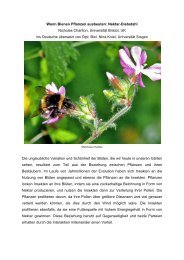PhDâ€theses - Ethologische Gesellschaft
PhDâ€theses - Ethologische Gesellschaft
PhDâ€theses - Ethologische Gesellschaft
You also want an ePaper? Increase the reach of your titles
YUMPU automatically turns print PDFs into web optimized ePapers that Google loves.
MATERNAL CARE STRATEGIES IN PHYLLONETA IMPRESSA (THERIDIIDAE)<br />
Nicole Gonswa<br />
nicolegonswa@alice‐dsl.net<br />
Research Update<br />
Diploma thesis, supervised by Prof. Dr. J.M. Schneider, Department of Biology, Zoological Institute &<br />
Museum, University of Hamburg<br />
Semelparous life‐history strategies evolve if chances of future reproduction are low due to<br />
extrinsic and intrinsic causes and often involve extreme forms of brood care. Brood care<br />
generally benefits the offspring by increasing survival and growth, and with maximal<br />
investment in a single brood or clutch females maximizes the number and/or the quality of<br />
their current young at the expense of future offspring. Semelparity in spiders evolved in<br />
several families and in some cases involves matriphagy: the consumption of the mother by<br />
the young. Obligate matriphagy as found in the eresid spider Stegodyphus lineatus implies<br />
that females forgo all possibilities of future reproduction even if their single brood turns out<br />
to provide suboptimal returns. However, conditions are rarely predictable and females<br />
should benefit if they retain the ability to opt for a second clutch if the first one survives and<br />
grows well without her terminal investment.<br />
I investigated whether the maternal care behaviour of Phylloneta impressa, a<br />
subsocial spider with excessive maternal care, shows plasticity. Females provide their young<br />
with regurgitated fluid and prey and finally, matriphagy terminates brood care. I collected<br />
females with cocoons and raised the offspring of these spiders to maturity in the laboratory.<br />
After maturation, females were mated and assigned to three different food treatments<br />
(high, low, no food availability) and maternal care behaviour and growth of young was<br />
documented.<br />
I found that these spiders practice facultative semelparity and flexibly adapt their<br />
brood care to the food availability and offspring needs. In the high food treatment, maternal<br />
care duration was shorter but the offspring developed slower than in other treatments.<br />
None of the females in the high food treatment was eaten by their young and 33 % of<br />
females survived the maternal care period and were able to successfully produce a second<br />
clutch. Matriphagy occurred only in broods with limited or no food. Additionally the<br />
occurrence of matriphagy depended on the number of spiderlings in the brood and was not<br />
observed in small broods. Matriphagy is the only form of cannibalism that was observed<br />
during my experiments; no siblicid was seen.<br />
My results show that a high plasticity is not excluded by the occurrence of<br />
matriphagy as an extreme form of brood care. My results further support the notion that<br />
matriphagy must not involve major physiological changes that preclude future reproduction.<br />
P. impressa opportunistally adjust their maternal investment in the current brood to<br />
offspring needs which are a function of the brood size and the availability of prey.<br />
13



